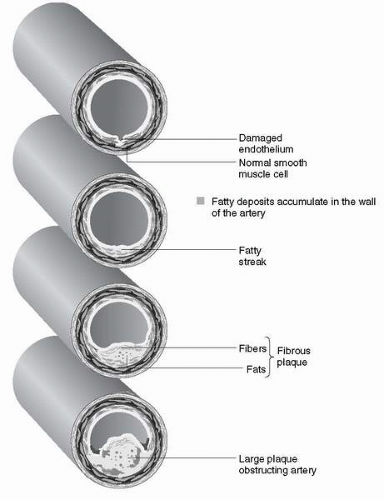Coronary Artery Disease
Coronary artery disease (CAD) is caused by diminished blood flow in the coronary arteries with subsequent reduced oxygenation to the myocardium, resulting in transient ischemia or angina. It may also cause permanent damage to the myocardial cells or infarction. Atherosclerosis and vasospasm are the most prevalent causes, with atherosclerosis being the most common. The left ventricle is most susceptible. The imbalance in supply and demand of oxygen can also be caused by cardiomyopathy and thrombus formation.
Coronary atherosclerosis remains the leading cause of death in the industrialized world and is the leading cause of death in women over age 50 years. CAD is the most common cause of heart attacks. Over 1 million Americans have myocardial infarctions
(MIs) each year, and it is estimated that there are 2 million Americans with silent ischemia.
(MIs) each year, and it is estimated that there are 2 million Americans with silent ischemia.
 Coronary atherosclerosis remains the leading cause of death in the industrialized world and is the leading cause of death in women over 50 years of age.
Coronary atherosclerosis remains the leading cause of death in the industrialized world and is the leading cause of death in women over 50 years of age.Table 34-1 Risk Factors for Coronary Heart Disease | |||||||||||
|---|---|---|---|---|---|---|---|---|---|---|---|
|
Nonmodifiable risk factors for CAD include age, gender, race, and family history. Men are more often affected than women by an overall ratio of 4:1, although after age 70 the ratio is 1:1. The incidence greatly increases among postmenopausal women and is higher among postmenopausal women who smoke. With increasing longevity, the incidence of CAD is expected to rise. White men have a higher incidence than African-American men, but the incidence of CAD among African-American women is higher than among white women. African-Americans have an earlier onset with more severe disease. The nature of the relationship to CAD is unclear and may be related to the higher incidence of other risk factors in African-Americans. The risk of CAD increases if a biological parent manifested CAD before the age of 55.
Modifiable risk factors that are most predictive of the development of CAD are dyslipidemia (high total cholesterol, high LDL, and low HDL), hypertension, diabetes, and cigarette smoking. Increased levels of homocysteine are also emerging as an important risk factor. Other, more controversial, risk factors are obesity, sedentary life-style, heavy alcohol consumption, estrogen deficiency, and a personality characterized by hostility. Research also suggests a genetic predisposition to CAD in positive family history. Additional research implicates infection and inflammation.
Stay updated, free articles. Join our Telegram channel

Full access? Get Clinical Tree




